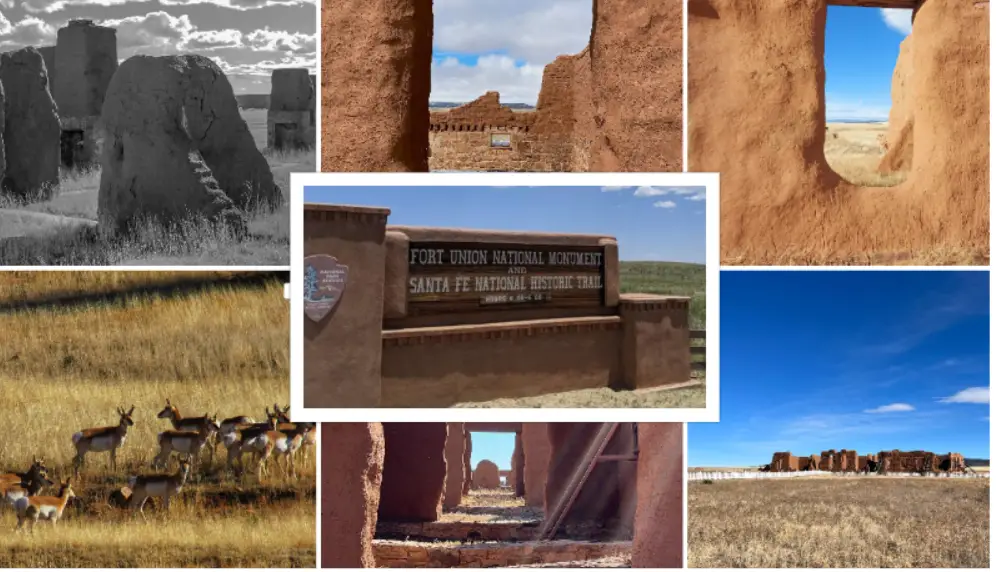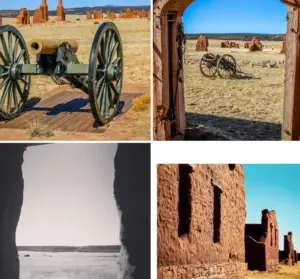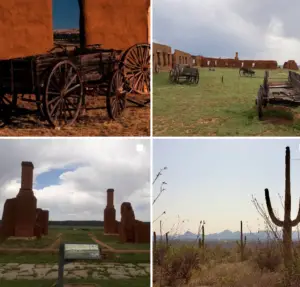Fort Union National Monument : Interesting Facts, History & Travel Guide

- By
- Aparna Patel
- |
- 1 Apr, 2023
- |

Nestled in the heart of northeastern New Mexico lies Fort Union National Monument, a historical site that offers a glimpse into the American West during the 19th century. Built in 1851, Fort Union was an important military post and served as a vital supply center for troops and civilians traveling along the Santa Fe Trail.
Over the years, Fort Union saw its fair share of conflict, including battles during the Civil War and numerous skirmishes with Native American tribes. Today, visitors can explore the remnants of this once-thriving fort, and gain a deeper appreciation for the challenges faced by those who lived and worked here.
In this blog, we will delve into the fascinating history and explore the interesting facts and travel guide of Fort Union National Monument, providing you with all the information you need to plan an unforgettable visit to this remarkable site.
Table of Contents
Interesting facts about Fort Union National Monument
Some interesting facts about Fort Union National Monument:
- Fort Union National Monument is located in the northeastern corner of New Mexico, near the border with Colorado.
- The fort was established in 1851 by the U.S. Army to protect travelers on the Santa Fe Trail.
- The fort played a key role in the Civil War, serving as a supply depot for Union troops in the Southwest.
- The fort was abandoned in 1891 and fell into disrepair, but was preserved as a historic site and designated as a national monument in 1954.
- Today, visitors can tour the restored fort buildings, which include barracks, officers’ quarters, and a hospital.
- The fort’s hospital is the oldest standing hospital in New Mexico.
- The fort also served as a major trading post, and visitors can see exhibits about the fur trade and the Santa Fe Trail in the visitor center.
- The fort was constructed using adobe, a building material made from mud, straw, and water. The adobe walls were several feet thick, providing protection from both the weather and potential attackers.
- In addition to its military and trading functions, the fort was also a center of cultural exchange between Native Americans and European settlers.
- The area around Fort Union National Monument is known for its natural beauty, with scenic drives, hiking trails, and opportunities for wildlife viewing in the nearby mountains and grasslands.
Information & History of Fort Union National Monument
Fort Union National Monument is a historic site located in northeastern New Mexico, about 8 miles north of the town of Las Vegas. The fort was established in 1851 by the U.S. Army as a way to protect travelers on the Santa Fe Trail, which was an important trade route between Missouri and Santa Fe, New Mexico.
The fort was strategically located at the junction of the Mountain and Cimarron branches of the Santa Fe Trail, and served as a major supply depot for troops stationed in the Southwest. The fort also played a significant role in the Civil War, serving as a supply depot for Union troops and a base of operations for campaigns against Confederate forces in the region.
Over the years, Fort Union grew to become one of the largest and most important forts in the Southwest, with a bustling trade in buffalo robes, furs, and other goods. The fort was also a center of cultural exchange between Native Americans and European settlers, and was known for its colorful mix of people and cultures.
In the late 1800s, however, the fort’s importance began to decline as railroads and other forms of transportation made the Santa Fe Trail less necessary. The fort was officially abandoned in 1891, and over the years many of its buildings fell into disrepair or were dismantled.
In the 1950s, however, efforts were made to preserve the site as a historic monument, and in 1954 Fort Union National Monument was established. Today, visitors to the park can tour the restored fort buildings and learn about the history of the Santa Fe Trail, the Civil War, and the cultural exchange between Native Americans and European settlers. The park also offers scenic drives, hiking trails, and opportunities for wildlife viewing in the nearby mountains and grasslands.
Read More:
- Fort Stanwix National Monument : Interesting Facts, History & Travel Guide
- Fort Pulaski National Monument : Interesting Facts, History & Travel Guide
- Fort Ord National Monument : Interesting Facts, History & Travel Guide
- Fort Monroe National Monument : Interesting Facts, History & Travel Guide
- Fort McHenry National Monument : Interesting Facts, History & Travel Guide
Travel Guide for Fort Union National Monument
Here is a travel guide for Fort Union National Monument:
- Location: Fort Union National Monument is located about 8 miles north of Las Vegas, New Mexico, in northeastern New Mexico.
- Getting there: The monument can be accessed via Interstate 25, which runs through Las Vegas. From I-25, take exit 366 and follow the signs to the monument.
- Hours of operation: The monument is open daily from 8:00 am to 4:00 pm, except for Thanksgiving, Christmas, and New Year’s Day.
- Admission: Admission to Fort Union National Monument is free.
- Things to see and do: Visitors to the monument can explore the restored fort buildings, including the barracks, officers’ quarters, and hospital. There are also exhibits about the Santa Fe Trail, the Civil War, and the cultural exchange between Native Americans and European settlers.
- In addition to touring the fort, visitors can also enjoy scenic drives, hiking trails, and wildlife viewing in the nearby mountains and grasslands. The monument is surrounded by the vast and beautiful grasslands of the High Plains, which are home to a variety of wildlife, including pronghorn antelope, mule deer, and coyotes.
- Facilities: The monument has a visitor center with exhibits, restrooms, and a bookstore. There are also picnic areas and hiking trails throughout the monument.
Tips for visitors:
- Wear comfortable shoes and dress appropriately for the weather, as much of the monument is outdoors.
- Bring sunscreen, a hat, and plenty of water, especially during the hot summer months.
- Be sure to stop by the visitor center to learn about the history of the monument and pick up a park map.
- Watch for wildlife, especially if you are driving on the park roads.
- Respect the historic buildings and artifacts, and stay on designated trails to avoid damaging the fragile grasslands.
- Consider attending one of the park’s ranger-led programs or guided tours to learn more about the history and ecology of the area.
Read More Articles:
- Fort Matanzas National Monument : Interesting Facts, History & Travel Guide
- Florissant Fossil Beds National Monument : Interesting Facts, History & Travel Guide
- Fort Frederica National Monument : Interesting Facts, History & Travel Guide
- Yosemite National Park: Interesting Facts, History & Information
Some frequently asked questions about Fort Union National Monument:
Q: What can I see and do at Fort Union National Monument?
A: Visitors to the monument can tour the restored fort buildings, including barracks, officers’ quarters, and a hospital. There are also exhibits about the Santa Fe Trail, the Civil War, and the cultural exchange between Native Americans and European settlers. Additionally, there are scenic drives, hiking trails, and opportunities for wildlife viewing in the nearby mountains and grasslands.
Q: How much does it cost to visit Fort Union National Monument?
A: Admission to the monument is free.
Q: What are the hours of operation for Fort Union National Monument?
A: The monument is open daily from 8:00 am to 4:00 pm, except for Thanksgiving, Christmas, and New Year’s Day.
Q: Is Fort Union National Monument accessible to people with disabilities?
A: Yes, the monument offers accessible facilities, including parking, restrooms, and some of the fort buildings.
Q: Can I bring my pet to Fort Union National Monument?
A: Yes, pets are allowed in the monument, but must be kept on a leash and are not allowed in the buildings or on the trails.
Q: Are there camping facilities at Fort Union National Monument?
A: No, there are no camping facilities within the monument. However, there are several campgrounds in the surrounding area.
Q: Are there guided tours or ranger programs available at Fort Union National Monument?
A: Yes, the monument offers guided tours and ranger programs throughout the year. Check the monument’s website or contact the visitor center for more information.
Q: What should I bring with me when visiting Fort Union National Monument?
A: Visitors should wear comfortable shoes, dress appropriately for the weather, and bring sunscreen, a hat, and plenty of water. Additionally, bring a camera and binoculars for wildlife viewing.
Search Posts
Latest posts
-
4 Mar, 2024
Can I accidentally miss the in-flight food?
-
5 Mar, 2024
Passing through airport security with autism
-
5 Mar, 2024
How to avoid drinking vodka?
-
4 Mar, 2024
Why would you wrap your luggage in plastic?
-
4 Mar, 2024
How can I do a "broad" search for flights?
Popular posts
-
5 Mar, 2024
Why prohibit engine braking?

